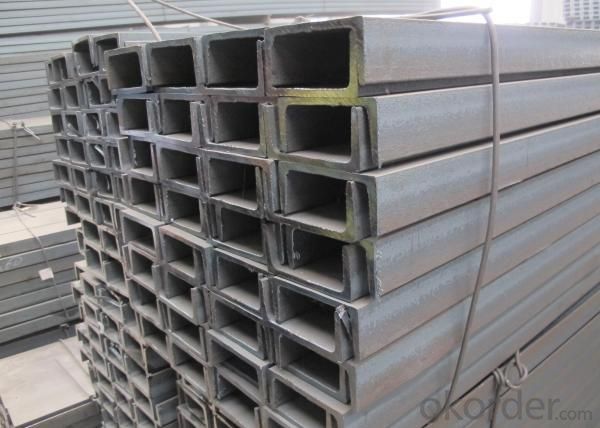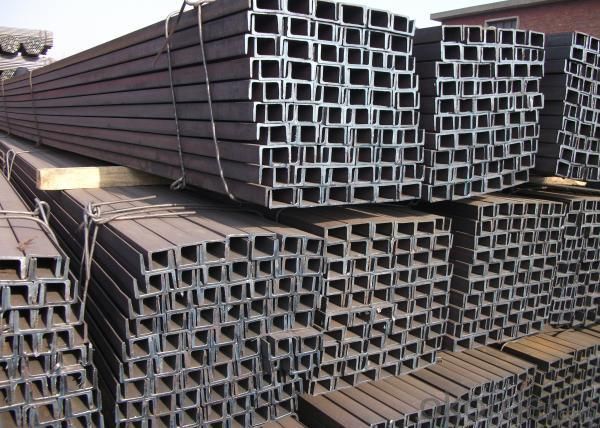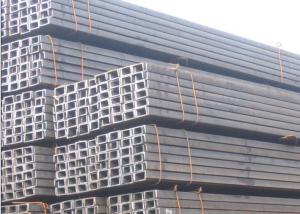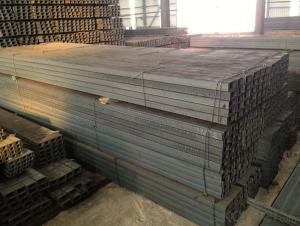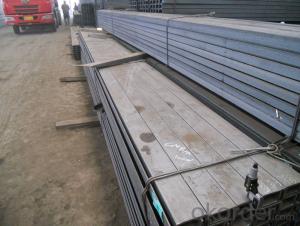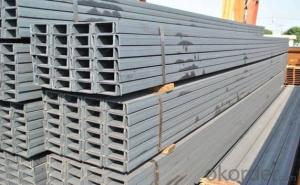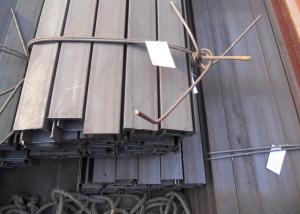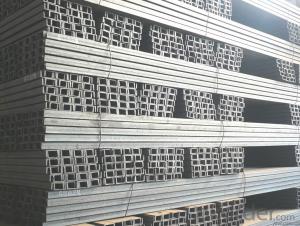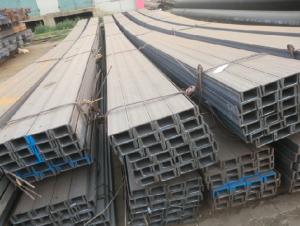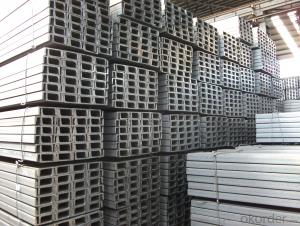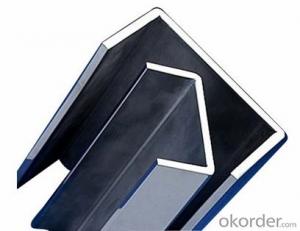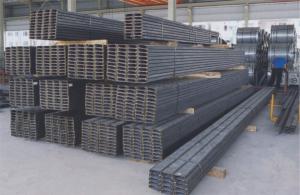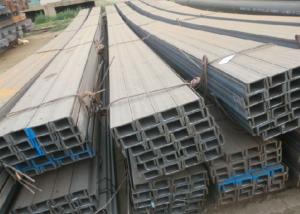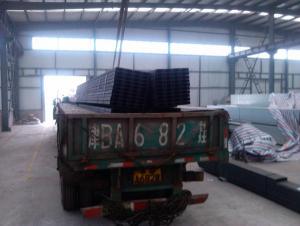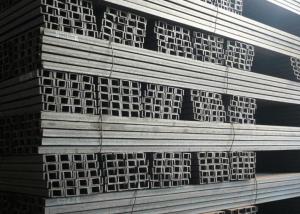Steel U Channel
- Loading Port:
- Xingang Port
- Payment Terms:
- TT or L/C
- Min Order Qty:
- 25 Tons m.t.
- Supply Capability:
- 1000 Tons Per Day m.t./month
OKorder Service Pledge
OKorder Financial Service
You Might Also Like
Specifications of Steel U Channel:
Standard Applied: GB Standard, EN Standard(UPN), JIS Standard
Sizes: 50mm to 300mm
Material Grade: Q235B, Q345B, S235JR, SS400, ASTM A36
As shown in the figure:
|
JIS U CHANNEL |
Standard h |
Sectional b |
Dimension s |
t |
Mass: Kg/m |
|
(mm) |
(mm) |
(mm) |
(mm) |
||
|
50x25 |
50 |
25 |
3.0 |
6.00 |
2.37 |
|
75X40 |
75 |
40 |
3.8 |
7.00 |
5.30 |
|
75X40 |
75 |
40 |
4.0 |
7.00 |
5.60 |
|
75X40 |
75 |
40 |
4.5 |
7.00 |
5.85 |
|
75X40 |
75 |
40 |
5.0 |
7.00 |
6.92 |
|
100X50 |
100 |
50 |
3.8 |
6.00 |
7.30 |
|
100X50 |
100 |
50 |
4.2 |
6.00 |
8.03 |
|
100X50 |
100 |
50 |
4.5 |
7.50 |
8.97 |
|
100X50 |
100 |
50 |
5.0 |
7.50 |
9.36 |
|
125X65 |
125 |
65 |
5.2 |
6.80 |
11.66 |
|
125X65 |
125 |
65 |
5.3 |
6.80 |
12.17 |
|
125X65 |
125 |
65 |
5.5 |
8.00 |
12.91 |
|
125X65 |
125 |
65 |
6.0 |
8.00 |
13.40 |
|
150x75 |
150 |
75 |
5.5 |
7.30 |
14.66 |
|
150x75 |
150 |
75 |
5.7 |
10.00 |
16.71 |
|
150x75 |
150 |
75 |
6.0 |
10.00 |
17.90 |
|
150x75 |
150 |
75 |
6.5 |
10.00 |
18.60 |
Note: We are able to supply other dimensions and sizes, which depends on the customer's requirements for the quantity.
Chemical Composition of Q235B Steel U Channel:
|
Alloy No |
Grade |
Element(%) | ||||
|
C |
Mn |
S |
P |
Si | ||
|
Q235 |
B |
0.12-0.20 |
0.3-0.7 |
≦0.045 |
≦0.045 |
≦0.3 |
Physical Properties of Q235B Steel U Channel:
|
Grade |
Yielding Strength Point(Mpa) | ||||
|
Q235B |
Thickness(mm) | ||||
|
≦16 |
>16-40 |
>40-60 |
>60-100 | ||
|
≧235 |
≧225 |
≧215 |
≧205 | ||
|
Tensile Strength(Mpa) |
Elongation After Fracture(%) | ||||
|
Thickness(mm) | |||||
|
≦16 |
>16-40 |
>40-60 |
>60-100 | ||
|
375-500 |
≧26 |
≧25 |
≧24 |
≧23 | |
Usage/Application of Steel U Channel:
The steel u channel can be applied to construction of warehouses, workshops, sport stadiums and car parks etc. In details, the steel u channel belongs to carbon structural steel which is applied to in the field of construction and machinery. The steel u channel is usually used for arch-itechtural structure, and they could be welded in order to support or hang a vari-ety of facilities. They are also usually used in combination with I beam. Generally,the steel u channel must possess perfect welding property, riveting property and mechanical property and so on.
Package & Delivery: Steel U Channel
The steel u channel will be packed in bundle with steel wire at each end of every bundle and color marking in order to help the customer to recognize his goods more easily at sight.
And steel u channel could be loaded into 20ft or 40ft container, or by bulk cargo. If the weight of each bundle reaches less than 3.5 mt, the loading by break bulk cargo should be choosed. When the weight of each bundle reaches less than 3mt, the loading by container should be choosed.
As for the transportaion from mill to loading port, the truck will be usually used. And the maximum quantity for each truck is 40mt.
All in all, we could do in accordance with customer's request

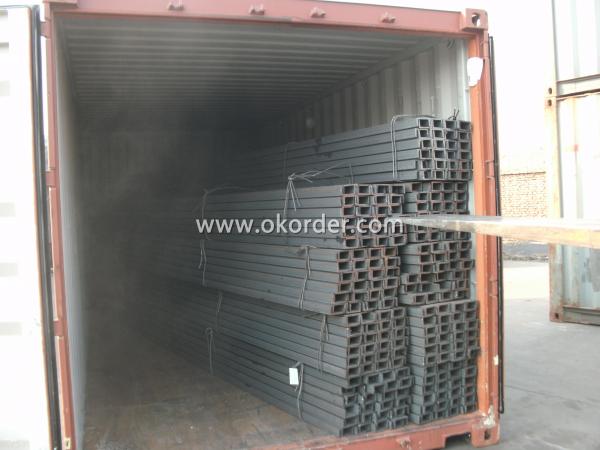
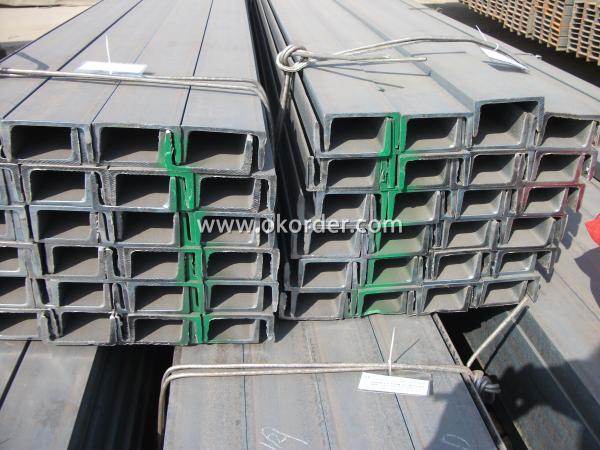
Production Flow of Steel U Channel:
1.The steel billet shall be heated in the high temperature furnace.
2. The heated steel billet shall be rolled five to nine times with the aim of shaping the general figure of steel u channel.
3. The rolled steel u channel should be put onto the cooling bed to make the temperature low.
4. The steel u channel should be straighted on the straightener.
5. The straighted steel u channel will be cut into meters by saw, as per customer's requirements.
- Q: Are steel channels suitable for electrical conduit systems?
- Yes, steel channels can be suitable for electrical conduit systems. Steel channels provide durability, strength, and protection for electrical wires and cables. They can withstand harsh environments, offer high load-bearing capacity, and protect against mechanical damage. Additionally, steel channels can be easily installed and provide a reliable and long-lasting solution for electrical conduit systems.
- Q: Can steel channels be used in solar panel mounting structures?
- Yes, steel channels can be used in solar panel mounting structures. Steel channels provide a strong and durable framework that helps support and secure solar panels in place. Their versatility and ability to withstand various weather conditions make them a suitable choice for solar panel mounting systems.
- Q: Can steel channels be used for scaffoldings?
- Scaffoldings can indeed utilize steel channels. In the construction industry, steel channels find widespread use for a multitude of purposes, one of which includes scaffolding systems. They possess exceptional strength, durability, and load-bearing capabilities, making them a fitting option for supporting both workers and materials at elevated heights. The assembly and disassembly of steel channels are effortless, allowing for a scaffold design that is flexible and adaptable. Moreover, their resistance to corrosion renders them perfect for outdoor applications, where exposure to weather elements is a concern. All in all, steel channels provide a dependable and robust solution for scaffoldings, guaranteeing the safety and stability of both workers and the construction project.
- Q: What are the advantages of using hot-rolled steel channels?
- There are several advantages of using hot-rolled steel channels in various applications. Firstly, hot-rolled steel channels have excellent structural integrity. The process of hot rolling involves heating the steel above its recrystallization temperature, which allows for a more uniform grain structure. This results in a stronger and more durable material that can withstand heavy loads and high stress levels. Secondly, hot-rolled steel channels have a wide range of sizes and shapes available, making them versatile for different construction projects. These channels come in various dimensions, including different heights, widths, and thicknesses, allowing for flexibility in design and application. Additionally, hot-rolled steel channels are cost-effective. The hot rolling process is efficient and relatively inexpensive, making hot-rolled steel channels more affordable compared to other structural materials. This makes them an attractive option for projects with budget constraints. Furthermore, hot-rolled steel channels have good workability. The hot rolling process enhances the ductility of the steel, making it easier to shape, cut, and weld. This workability allows for efficient fabrication and customization of the steel channels to meet specific project requirements. Lastly, hot-rolled steel channels have a high degree of recyclability. Steel is one of the most recycled materials globally, and hot-rolled steel channels can be easily recycled and repurposed without losing their structural properties. This makes them an environmentally friendly choice and contributes to sustainable construction practices. In conclusion, the advantages of using hot-rolled steel channels include their superior structural integrity, versatility in size and shape, cost-effectiveness, good workability, and recyclability. These advantages make hot-rolled steel channels a popular choice in various industries, including construction, manufacturing, and infrastructure development.
- Q: What are the load-bearing properties of steel channels?
- Steel channels have excellent load-bearing properties due to their structural design and material strength. They are capable of supporting heavy loads and distributing weight evenly, making them suitable for various applications such as construction, infrastructure, and manufacturing. Steel channels provide stability and durability, allowing them to withstand significant forces and maintain their structural integrity under pressure.
- Q: What's the width of the 22 channel wing?
- I am now with the project is channel 20A 22, channel steel has two specifications, 22a and 22b 22, said channel steel waist length 22cm
- Q: How many meters per ton is channel ten?
- 10# channel steel weighs 10.007kg per meter, a ton, theoretically 99.93 meters
- Q: Many of the equipment in the substation is installed on the support of the channel, why not directly mounted on the support plate. Why should we add channel steel to the top plate?What effect can this channel play?
- Keep all switchgear in good condition;
- Q: Can steel channels be used for roof truss systems?
- Yes, steel channels can be used for roof truss systems. Steel channels are commonly used in construction for their strength and durability, making them suitable for supporting roof trusses and distributing the weight of the roof.
- Q: How are steel channels measured and specified?
- Steel channels are measured and specified based on their dimensions and properties. The measurement of steel channels includes their height, width, and thickness. The height of a channel is usually measured as the vertical distance between the top and bottom flanges. The width refers to the horizontal distance between the flanges. The thickness, also known as the gauge, is the distance between the inner surfaces of the flanges. It determines the strength and load-bearing capacity of the channel. The thickness is usually measured in millimeters or inches. In addition to these basic measurements, steel channels are also specified based on their weight per unit length. This weight is commonly expressed in pounds per foot or kilograms per meter. It is essential for calculating the total weight of the channel required in a construction project. Steel channels may also have specific designations or grades based on their composition and properties. For instance, some channels may be designated as "C" channels, while others may be classified as "MC" or "S" channels. These designations indicate the shape and structural properties of the channel. Specifying steel channels involves providing detailed information about the desired dimensions, thickness, weight, and any specific grade or designation required. This information helps in accurately procuring and utilizing the appropriate steel channels for a construction or engineering project.
1. Manufacturer Overview
| Location | Hebei, China |
| Year Established | 1993 |
| Annual Output Value | Above US$100 Million |
| Main Markets | South Asia Middle East; Southeast Aisa; south Korea |
| Company Certifications | ISO 9001:2000 |
2. Manufacturer Certificates
| a) Certification Name | |
| Range | |
| Reference | |
| Validity Period |
3. Manufacturer Capability
| a) Trade Capacity | |
| Nearest Port | Tianjin; |
| Export Percentage | 1% - 10% |
| No.of Employees in Trade Department | 11-20 People |
| Language Spoken: | English; Chinese |
| b) Factory Information | |
| Factory Size: | Above 20,000 square meters |
| No. of Production Lines | 1 |
| Contract Manufacturing | OEM service offered |
| Product Price Range | average |
Send your message to us
Steel U Channel
- Loading Port:
- Xingang Port
- Payment Terms:
- TT or L/C
- Min Order Qty:
- 25 Tons m.t.
- Supply Capability:
- 1000 Tons Per Day m.t./month
OKorder Service Pledge
OKorder Financial Service
Similar products
Hot products
Hot Searches
Related keywords



